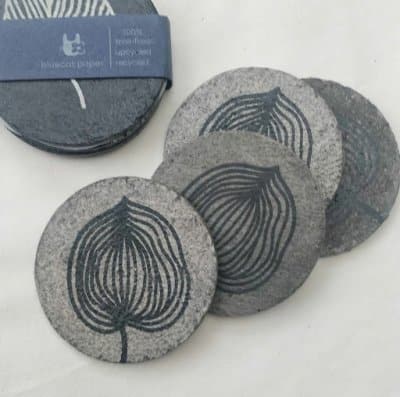Table of Contents
Drink Coasters Are So Famous, But Why?
Whether it’s sitting on your coffee table or on the counter at your favourite bar, the coaster has been a drink’s best friend for years.
Coasters were first designed for decanters or wine bottles, so they could be slid around the dinner table after the household help had retired. Drink Coasters were also called ‘Beer Mats’. These were very popular in use after about 1770. The coasters soak up condensation and serve as a barrier to heat.




Who Invented the Beverage Coaster?
The history of coasters started in Germany. The true inventor is still ambiguous. Some people believe it was founded as a sawmill operation in 1757, and beer coasters as we know them didn’t exist until the 1880s until a print shop named Friedrich Horn made the first “beermats” from cardboard.
In 1892, Robert Sputh, patented beer mats called bierdeckels in Dresden. He followed a process of pouring liquefied wood pulp into moulds and letting the pulp dry out to make Coasters or Beer Mats.
Why are drink coasters called coasters?
From the 1570s a ship that traded from port to port along a coast was called a “COASTER.” By 1874 the term “BOTTLE COASTER” was used to describe a ‘low, round tray’ used to hold a wine bottle and used as a decanter.
These bottle coasters had wheels enabling the device to be wheeled, or ‘coasted’ around the table to each of the diners at the table. It’s easy to see how the protective mat we now know was a direct development of the original bottle coaster and as such ‘borrowed’ the name in the 1900s and it has stuck to this day.
Why use a coaster?
Coasters are great as decoratives, but the real purpose is way more than just being a decorative piece. They protect the surface of a table or any other surface where the drink is placed.
Beverage coasters are absolutely necessary when you place your hot or cold drink on that beautiful furniture. The condensation from the drink can stain and ruin your table.
Drip mats also stop your table from rotting as the moisture from cold drinks can rot wooden tables as it seeps into them and rots them from the inside or it stops that hot drink from burning the table surface.
Coasters placed on top of a beverage can also be used to show that a drink is not finished or to prevent contamination (usually from insects).
What are the most common materials used in making coasters?
Coasters are made from every possible material that’s available. Coasters are most commonly made out of Paper, Sandstone, Wood, Slate, unglazed ceramics and many more
Coasters that can absorb the moisture are the materials. Here at Bluecat Paper, we have achieved similar results with our paper products. We only make tree free paper and everything that we make is 100% handmade. Therefore, not only will you be acquiring an excellent product, but you will also be doing your part for the environment.
At Bluecat Paper, we have wonderful coasters for every occasion made from multiple waste materials like cotton mache and paper mache. They come in a variety of designs and beautiful prints.
Our coasters elevate the beauty of your table and now you never have to worry about ruining your wooden table with those ugly watermarks.




How coasters are made at Bluecat Paper
At Bluecat Paper we produce 100% TREE-FREE PAPER & sustainable handmade paper and products. The paper and products we create is upcycled and recycled without cutting down a single tree.
To make the handmade coasters, cotton rags are beaten with water to create a pulp like mixture. To make the cotton mache, the cotton pulp is mixed with cornstarch and natural glues in order to stick together, take shape and harden in a mould.
Once the desired consistency is reached, the mixture is moulded into shape and is left to dry and harden. After drying, the coasters are then sanded to make them smooth. Thereafter, they are screen printed by hand to give the most beautiful and accurate designs.
After this process, the coasters are coated with cornstarch to make it resistant to staining. Only after rigorous quality checks are the coasters sent to shops near you.
At Bluecat paper we believe that we should protect the one world we have with all our heart. Therefore, all of the water used is sent to an effluent treatment plant to be recycled back into production.
We hope that “tree-free paper & products” becomes mainstream. We strive to give you the best quality products while making sure the planet is a better place. Choose sustainable products to make that change.


